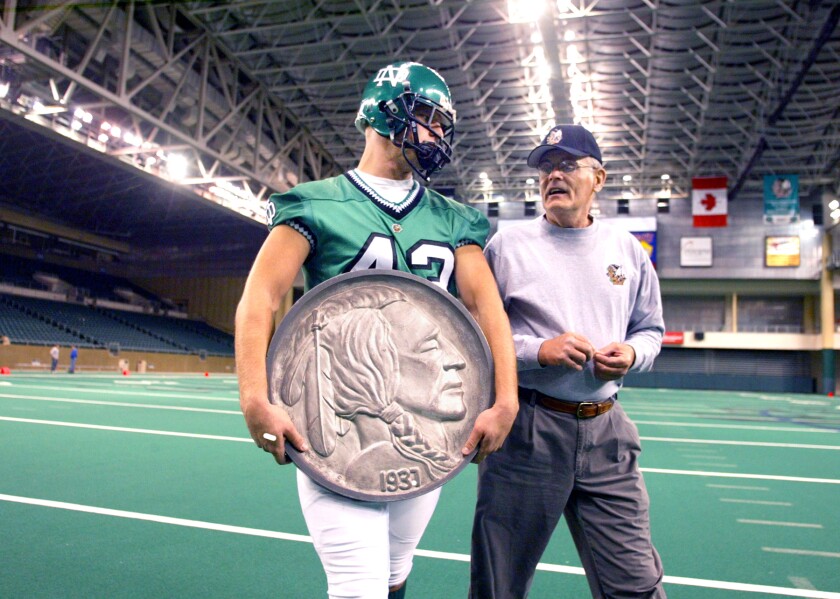GRAND FORKS — The morning of June 4, 2018, started out like most weekday mornings.
Matt Vanderpan had dropped his kids off at day care and school, and was on his way to his parents’ home in East Grand Forks. He stopped at a gas station for a bite to eat.
ADVERTISEMENT
While standing in line to pay, “something didn’t feel right,” he recalled. He had a kind of metallic taste in his mouth and felt his balance was off.
He thought it was a passing dizziness that would probably go away, he said.
Vanderpan continued on his way, but then “everything just kind of turned into pandemonium,” he said. “Things got blurry; it felt like everything was spinning really fast. My hands fell away from the steering wheel. And my legs weren’t working correctly. Small parts of my field of vision were not quite as blurry as the rest of it.”
He was able to pull his pickup over and stopped not far from his parents’ home. He called his wife. By the time she arrived, the episode “was starting to go away, and I insisted we go home,” he said. But there, the severity of his condition became evident.
“I couldn’t get him out of the car,” McKynsay Vanderpan remembered. She knew then that her husband's problem was worse than vertrigo or temporary dizziness.
“We went right to the ER. I called his doctor, too,” she said. “And the same day, we were shipped to Fargo.”
Scans at Altru had revealed that Matt Vanderpan, an active, healthy husband and father of three young children, had had a stroke.
ADVERTISEMENT
“I was 38 at the time,” he said. “That was the last thing on the list of anything that I would have considered happening to me.”
He was hospitalized at Essentia for five days, followed by a 10-day inpatient stay at the Altru rehabilitation facility in Grand Forks, where “I learned how to do pretty much everything,” he said.
Doctors could not say exactly why he had the stroke, he said, but they surmised that an arterial wall in his neck had not formed properly — maybe even as an infant — and “it took 38 years for it to fail,” Vanderpan said. “For whatever reason, it failed that day.”
Doctors told him a small piece of the arterial wall in his neck broke off and sent five clots to various parts of his brain. Fortunately, he did not need surgery and did not have a speech deficiency to the extent that he needed speech therapy.

Long recovery
As an inpatient at the Altru rehabilitation center, Vanderpan worked very hard to regain his health.
“I didn’t want to be in a wheelchair for the rest of my life, after doing that for a week I didn’t want to do that any longer than I had to,” he said. “I believed if I worked at it that that was not going to be a permanent thing for me.”
ADVERTISEMENT
“I was worried that the self-imposed victimhood would be worse than if the stroke had been fatal, and I didn’t want that to happen. So I tried to work very hard at not letting it become the thing that most defines me,” he said. “And I wanted to get to a point as soon as I could where people I didn’t know couldn’t tell that something bad had happened to me.”
After his inpatient stays, he took about six months of occupational and physical therapy, working several days a week as an outpatient. After completing that therapy, he has continued to work on strength conditioning and improving his balance and dexterity.
Some things take longer for him to do than in the past, he said. And some everyday tasks are still “incredibly difficult,” including “things you do without thinking specifically about it.”
Even the act of getting up and walking required conscious effort, he said. “There are a lot of things you don’t think about, until you have to think about it.”
In his journey to recovery, he remembered how to do things, “but the corresponding movements with my arms or my legs just didn’t happen. It was hard, just hard.”
Vanderpan said, “I’m as recovered as I think I’m going to be,” he said, noting that there still are some deficiencies. “I’m pretty critical of myself. If there’s something I can’t do, I try to focus on that.”
Cory Edward, Altru neurologist, said “stroke is more of a disease of the elderly,” but it can and does occur in people of all ages, even as young as elementary school-age.
ADVERTISEMENT
Knowledge of stroke symptoms is generally lacking in younger people, Edward said. They should be alert to changes in balance and speech, blurred vision, arm weakness and facial drooping, and act quickly to get medical help.
“We only have a little bit of time to treat” stroke victims and medications, administered quickly, can lead to much improved outcomes. He recommends regular check-ups with primary care providers who can monitor physical data, such as blood pressure, which “is an important modifiable risk factor for stroke.”
Changes perspective
The stroke shifted his perspective on life, especially given that he's a husband and father of young kids, he said. He's well aware that he could have died.
“I feel very fortunate to have been married to my wife,” who teaches in the University of North Dakota athletic training program and works as a trainer for UND sports teams.
“I appreciate things I previously may have found insignificant or not worthy of notice,” he said.
It’s important that younger people “be aware of signs and symptoms of stroke,” Vanderpan said. “I was surprised (to have a stroke). I was a pretty young person, healthy and active.
“A lot of people have strokes and they’re not always older people.There are a lot of contributing factors that can lead to a stroke. It can happen to anybody.”
ADVERTISEMENT













